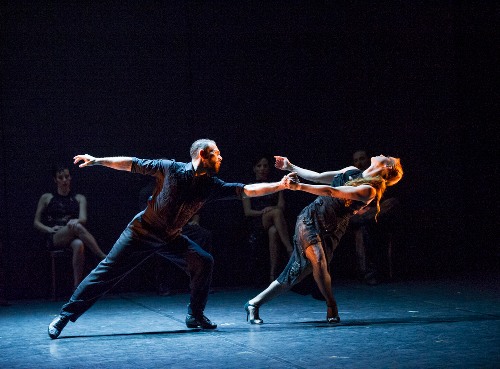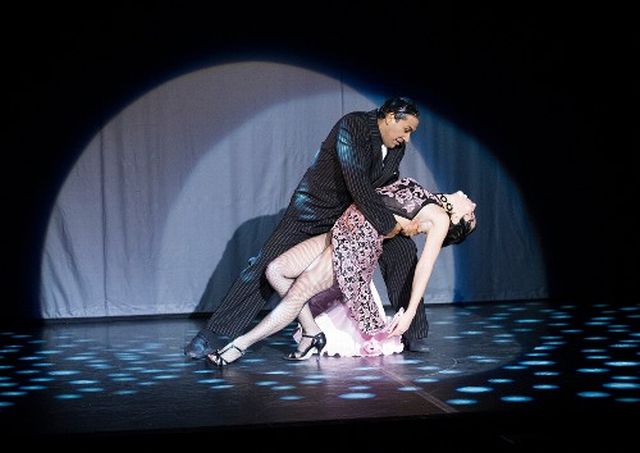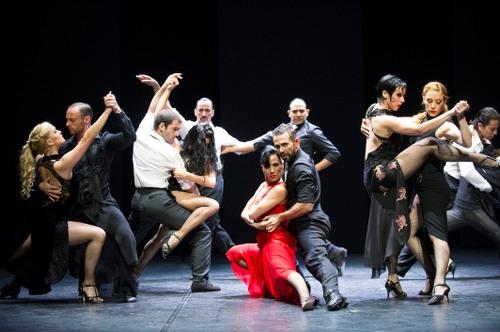Can tango ever really be interesting as a pure dance stage show? After all, like most forms of social dance, its truest incarnation is in the fleeting and contingent encounters of the dance hall, the public ball, the open-to-all-comers late night bar. Making tango slick, polished, professional and repeatable enough to put behind a proscenium has all too often made it clichéd and even boring, predictably marketed through the putative sex appeal of tight dresses, twining ankles, and “Latin passion”. But by taking both the name and the inspiration for his latest piece from milongas, tango’s informal social evenings, that choreographic chameleon Sidi Larbi Cherkaoui has made a commendable effort to get past the satin-and-stilettos image in order to put relationships centre stage.
Larbi uses five top-flight professional tango couples and the guidance of highly respected tango veteran Nélida Rodriguez to ensure that the tango elements of the show are of the highest quality. But Larbi’s own take shines through, from the opening scene of a couple dancing back to back, to the frequent use of trios instead of couples, and in the storyline of two contemporary dancers who start by observing from the sidelines, then work out their relationship through a blend of contemporary dance and tango. Milonga is structured as a simple series of vignettes, all of which (apart from the videos, which we’ll come to later) put the dancing quite properly on the front foot.
 Esther Garabali’s movement should probably get her reclassified as more liquid than solid, while Melina Brufman (pictured left) steps as precisely and fastidiously as a cat in snow – but at the pace of sub-machine-gun fire. The best vignettes are those where something unusual happens – however wonderful Garabali’s movement, she is still cast in the tedious role of a woman who huffily fends off a man’s predatory advances, but – surprise! - turns out to like it really and then becomes needy and hysterical when he loses interest. Much more powerful are the trio of men who dance with the exhibitionist flair of teenage breakdancers but whose faces evoke a Sharks and Jets-like tension, even as their bodies slide through tango's loving embraces.
Esther Garabali’s movement should probably get her reclassified as more liquid than solid, while Melina Brufman (pictured left) steps as precisely and fastidiously as a cat in snow – but at the pace of sub-machine-gun fire. The best vignettes are those where something unusual happens – however wonderful Garabali’s movement, she is still cast in the tedious role of a woman who huffily fends off a man’s predatory advances, but – surprise! - turns out to like it really and then becomes needy and hysterical when he loses interest. Much more powerful are the trio of men who dance with the exhibitionist flair of teenage breakdancers but whose faces evoke a Sharks and Jets-like tension, even as their bodies slide through tango's loving embraces.
 Serious faces seem to be the norm in tango, which may be why the audience, including me, so much appreciated the comic turn of Cristian Cisneros and Valentina Villarroel (pictured right). Villarroel shows herself to be a gifted slapstick artist, playing a tourist tottering about, pouting and playing dumb, before letting Cisneros as a greasy, paunchy wide boy give her a good time.
Serious faces seem to be the norm in tango, which may be why the audience, including me, so much appreciated the comic turn of Cristian Cisneros and Valentina Villarroel (pictured right). Villarroel shows herself to be a gifted slapstick artist, playing a tourist tottering about, pouting and playing dumb, before letting Cisneros as a greasy, paunchy wide boy give her a good time.
The videos, though (by Eugenio Szwarcer) are a problem: streetscape montages with a flâneur feel are just about bearable, but the sequence of a single dancer “controlling” different video projections looks like an advert for the latest touchscreen operating system rather than a dance piece. Using videos of the dancers themselves as backdrop to their performances is an interesting touch, evoking the necessary non-identity of repetition in performance, as well as the multitude of possibilities in any tango encounter, but there is too much of it.
Milonga is unlikely to cause any intellectual or aesthetic epiphanies
Tango itself can often become too much after about an hour – however innovative the choreography, however good the dancers, it still has a movement profile that starts to look samey quite quickly. The contemporary interludes provided by Silvina Cortes and Damian Fournier offer welcome breaks – look, people changing levels! moving without stepping! - as well as attractive bits of storytelling in their own right.
Larbi does better than most at putting tango on the stage without losing its private magic, but Milonga is unlikely to cause any intellectual or aesthetic epiphanies in its audience. In the end, this is a vehicle for excellent dancers, not a nineteenth century novel, and it is more absorbing than many tango shows, despite the unnecessary and irritating video distractions.
- Milonga is at Sadler's Wells until 10 November














Add comment